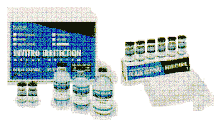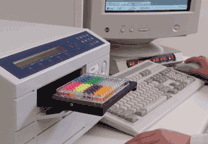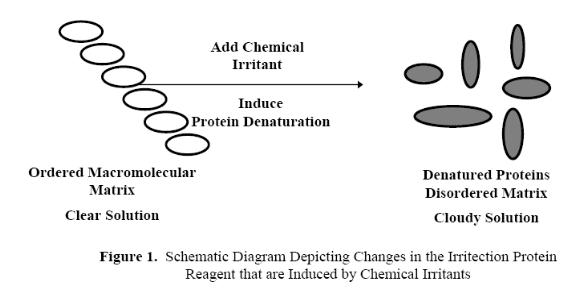|
IRRITECTION
www.Lab365.co.kr
동물을 이용한 드레이즈 테스트 (draize test), 안자극성 실험을 대체 함
동물을 이용한 피부 자극성 실험을 대체 함
What is the Irritection Assay System? 
The Irritection Assay System is a standardized, quantitative invitro test method that can be employed to detect, rank, and predict the ocular and/or dermal irritation potential of cosmetics, consumer products, pharmaceuticals, and chemical raw materials. This advanced technology enhances and replaces the Company's earlier Eytex and Skintex products.
Why Use the Irritection Assay System?
- The Irritection Assay System provides a reliable alternative to the traditional animal tests of ocular and/or dermal irritancy, and is considerably less expensive than in vivo tests.
- Irritection data may be obtained in as little as 5 hours, versus the standard 2-3 weeks required for in vivo studies. Rapid results provide quicker feedback on formulation changes and significantly decrease product development times.
- The Irritection assays are quantitative and highly reproducible, thus allowing comparative ranking of samples and formulations with great accuracy.
- Prior studies have demonstrated that the Irritection assay results are highly correlated with those obtained in standard Draize tests.
Ocular Irritection Assays
The corneal irritancy of test materials is known to be related to their propensity to promote denaturation and disruption of corneal proteins. The Ocular Irritection Assay System is an in vitro test method that mimics these biochemical phenomena. This test consists of two essential components:
- A membrane disc that permits controlled delivery of the test material to a reagent solution and;
- A proprietary reagent solution that is composed of proteins, glycoproteins, lipids and low molecular weight components that self-associate to form a complex macromolecular matrix.
Controlled mixing of the test material and the reagent solution during the assay incubation period promotes protein denaturation and disaggregation of the macromolecular matrix.
The changes in protein structure that are induced by the test material may be readily quantitated by measuring the resulting changes in turbidity (OD405) of the reagent solution.
Comparison of these optical density measurements to those produced by standard chemical irritants permits calculation of an "irritancy score" that has been shown to be directly related to the potential corneal irritancy of the test material.
Dermal Irritection Assays
Chemicals that cause dermal irritation are known to induce alterations in the structure of keratin, collagen and other dermal proteins. The Dermal Irritection Assay System is an in vitro test that mimics these biochemical phenomena.
This test also consists of two components:
- A membrane substrate that has been modified by covalently crosslinking a mixture of keratin, collagen and an indicator dye to it and;
- A reagent solution consisting of a highly organized globulin/protein macromolecular matrix.
Application of an irritant chemical to the membrane disc disrupts the ordered structure of keratin and collagen and results in release of the bound indicator dye. Additionally, dermal irritants induce changes in conformation in the globular proteins found in the reagent solution.
The extent of dye release and protein denaturation may be quantitated by measuring the changes in optical density of the reagent solution at 450 nm (OD450).

Comparison of these optical density measurements to those produced by standard chemical irritants permits calculation of an "irritancy score" that has been shown to be directly related to the potential dermal irritancy of the test material.
Irritection test
Irritection test는 InVitro Internation이 초기에 개발한 Eyetex, Skintex에서 좀 더 개량된 것임. 이름 그대로 Eytex는 토끼의 눈을 이용한 Draize test (안자극성 시험)를, Skintex는 피부자극성 (dermal irritancy) 시험을 대체할 수 있는 방법으로 개발된 것임.
따라서 Irritection test의 원리를 이해하기 위해서는 우선 Draize test와 dermal irritancy test의 기본적인 시험원리를 이해해야할 것임.
Draize test
정상적인 눈의 각막은 투명하며 각막 자체는 아주 많은 종류의 단백질과 탄수화물로 구성이 되어 있는데, 각막이 투명하게 보이는 이유는 이들 단백질 및 탄수화물들이 고도로 잘 정연된 구조를 취하고 있기 때문. 이렇게 정연한 구조를 취하고 있기 때문에 각막을 통하여 들어오는 빛이 눈 안쪽으로 잘 전달되어 잘 볼 수 있는 것임. 만일 각막이 자극성 물질에 노출되면 각막의 단백질과 반응하여 원래의 정상적인 정연했던 구조를 파괴하게 되는데, 이 때 각막이 혼탁해지는 것이며 이 혼탁될 때까지의 시간이나 정도를 측정하여 안(眼) 자극성의 독성 여부를 검사하는 것이 Draize test임. InVitro international은 단백질과 당단백질의 고유의 혼합물을 이용하면 in vitro 상에서도 Draize test와 유사한 결과를 재현할 수 있다는 것을 발견하였음. 즉, 각막을 구성하는 단백질과 유사한 성질을 갖는 단백질이 kit에 포함되어 있는 것임.
InVitro International의 Ocular Irritection test의 kit상에 있는 고유의 단백질 및 당단백질의 혼합물은?
주된 성분은 12개의 subunit (흔히, 써브유닛이라고 얘기함. 예를 들어 인슐린이라는 단백질은 A subunit와 B subunit로 구성되어 있음)으로 구성된 oligomeric (복합) 단백질임. 이 단백질의 분자량은 320 KD (kilodalton) 정도이며, 비공유결합에 의해 자기네들끼리 결합하여 커다란 fibrils (즉, 실과 같은) 구조를 취하게 된다. 그 외에 탄수화물, 지질 및 기타 저분자량의 성분들로 구성되어 있음. 이상의 것들은 동결건조된 상태로 있는데, 일단 이것을 buffer (완충액)로 녹이면, oligomeric 단백질이 이들 탄수화물, 지질, 기타 저분자량의 물질들과 결합하여 정연한 구조의 matrix (매트릭스, 기질)가 되는데 이것은 각막의 그 구조와 매우 유사하다.
Irritection test의 유효성
여러 종류의 자극성 물질들 (chemical irritants)을 이 Irritection test kit에 함유된 단백질 성분과 반응을 시키면, 각막의 단백질에서 일어나는 것과 매우 유사한 반응이 일어난다는 것이 확인되었음. 예를 들어 이온성 계면활성제는 Irritection test에서 양성반응 (즉, Irritection test kit의 시약 (protein reagent = 단백질 성분등)이 혼탁해짐)을 일으키는데, 이들 물질들은 각막에서도 유사한 반응을 일으킨다. 이것은 이들 물질들이 단백질의 변성 (denaturation)을 촉진시키기 때문인데, 단백질이 변성되면서 단백질 고유의 3차원적인 구조가 바뀌게 된다 (단백질의 변성은 말 그대로 단백질 고유의 성질이 바뀐다는 뜻임. 단백질은 각각 고유의 입체적인 구조를 갖고 있는데, 이러한 구조와 단백질 고유의 기능은 매우 밀접한 연관성이 있음. 예를 들어 인슐린은 혈당을 조절하는 단백질인데, 만일 인슐린의 구조에 변화, 즉 변성이 일어나면 그 기능이 상실됨). 이러한 변성과 함께 단백질 및 기타 물질들로 구성된 매트릭스의 질서정연했던 구조가 깨지면서 침전되는 물질이 생기기 시작하여 혼탁해지는 것이다.

이러한 현상 (단백질 (혹은 Irritection test kit의 시약 =protein reagent)이 혼탁해지는 것)은 400 nm의 파장에서 흡광도를 측정함으로써 정량화할 수 있다.
Dermal Irritection assay system
Ocular Irritection test system과 유사점과 차이점
1. 유사점
Ocular Irritection test의 protein reagent가 각막의 단백질의 구조를 모방했듯이, Dermal Irritection test도 피부의 단백질에서 일어나는 단백질의 변성등의 변화를 측정함.
2. 차이점
1) Dermal test의 synthetic biobarrier membrane (합성 경계막이라고 번역해야 할까?)이 Ocular test보다 약간 더 복잡함. 그 이유는 섬유성막 (cellulose membrane)으로 되어 있는 이 biobarrier membrane에 keratin과 collagen을 coating하여, 가능한한 진피 (dermis)가 갖고 있는 특성을 재현할려고 하였기 때문임. 그리고 제조과정 중에 이들 keratin과 collagen에 붉은 색소를 흡착시켰음. 만일 이 색소가 유리되어 나올 경우에는, 시험물질이 keratin/collagen의 biobarrier를 파괴한다는 것을 쉽게 알 수 있게 하였음.
2) 단백질 시약 (protein reagent)의 조성 성분에 약간의 차이가 있음. 즉, Dermal test에는 Ocular test에는 없는 globulins (글로불린)이라는 단백질이 포함되어 있음
3) 결과의 판정을 400 nm가 아닌 470nm의 파장에서 판독함
|